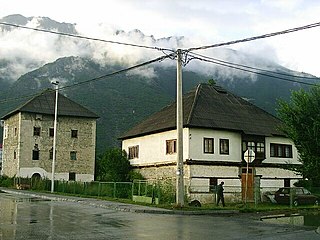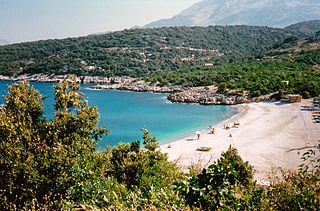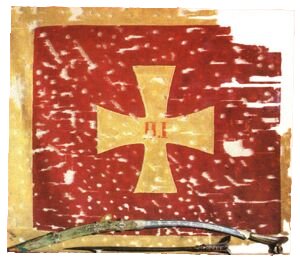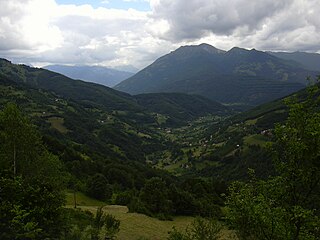
Gusinje is a small town in Montenegro in the northern region. According to the 2011 census, the town has a population of 1,673 and is the administrative center of Gusinje Municipality.

Plav Municipality is one of the municipalities of Montenegro. It is located in northern Montenegro. The center is the town of Plav. In February 2014, the south-western third of the municipality seceded to form Gusinje Municipality.
Albanians in Montenegro are an ethnic group in Montenegro of Albanian descent, which constitute 4.91% of Montenegro's total population. They are the largest non-Slavic ethnic group in Montenegro.

Kelmendi is a historical Albanian tribe (fis) and region in Malësia and eastern Montenegro. It is located in the upper valley of the Cem river and its tributaries in the Accursed Mountains range of the Dinaric Alps. The Vermosh river springs in the village of the same name, which is Albania's northernmost village. Vermosh pours into Lake Plav.

Kuči is a historical tribe (pleme) of Albanian origin and a region in central and eastern Montenegro, north-east of Podgorica, extending along the border with Albania. Processes of Slavicisation during the Ottoman era and onwards facilitated ethno-linguistic shifts within much of the community. As such, people from the Kuči today largely identify themselves as Montenegrins and Serbs, with a minority still identifying as Albanians. In other areas such as the Sandžak, many Muslim descendants of the Kuči today identify as Bosniaks.

Ali Pasha Shabanagaj was an Albanian Muslim military commander and one of the leaders of the League of Prizren. He governed, as an Ottoman kaymakam (sub-governor), an area in what is today eastern Montenegro around Plav and Gusinje. He was commonly known as Ali Pasha of Gusinje. He was the leader of the Albanian irregular troops of the League of Prizren against the Principality of Montenegro at the Battle of Novšiće. He was governor of the area of Plav and Gusinje located in a valley between steep mountains.

Mrkojevići is a historical ethno-local community and region in southwestern Montenegro, located between the towns of Bar and Ulcinj. The region borders Krajina to the east. The Mrkojevići form a distinct ethno-geographical group with their own dialect of the Serbo-Croatian language, while also exhibiting a degree of bilingualism in Albanian. Their customs are distinct from their neighbouring Slavic and Albanian communities, but they also show influence and contacts with them. In the 400-year Ottoman period, the Mrkojevići converted to Islam, which forms an important aspect of their cultural identity.

The Montenegrin–Ottoman War, also known in Montenegro as the Great War, was fought between the Principality of Montenegro and the Ottoman Empire between 1876 and 1878. The war ended with Montenegrin victory and Ottoman defeat in the larger Russo-Turkish War of 1877–1878. Six major and 27 smaller battles were fought, among which was the crucial Battle of Vučji Do.

Hoti is a historical Albanian tribe (fis) and sub-region of Malësia, a divided area located in northern Albania and southern Montenegro. Its geography is mostly mountainous, but some of its villages are on flat terrain near the banks of Lake of Shkodër.

Bjelopavlići is a historical tribe (pleme) of Albanian origin and a valley in the region of the Brda, in Montenegro, around the city of Danilovgrad.
Vusanje is a village in Gusinje Municipality, Montenegro. According to the 2003 census, the town had 648 inhabitants.

The Sanjak of Scutari or Sanjak of Shkodra was one of the sanjaks of the Ottoman Empire. It was established after the Ottoman Empire acquired Shkodra after the siege of Shkodra in 1478–9. It was part of the Eyalet of Rumelia until 1867, when it became a part, together with the Sanjak of Skopje, of the newly established Scutari Vilayet. In 1912 and the beginning of 1913 it was occupied by members of the Balkan League during the First Balkan War. In 1914 the territory of Sanjak of Scutari became a part of the Principality of Albania, established on the basis of the peace contract signed during the London Conference in 1913.
The Battle of Novšiće was a battle for control over Plav and Gusinje fought on 4 December 1879 between forces of the Principality of Montenegro led by Marko Miljanov and local pro-Ottoman forces which included irregulars of the League of Prizren, both commanded by Ali Pasha, the Kaymekam of Gusinje. The League of Prizren consisted mainly of Albanians from Plav and Gusinje in Scutari Vilayet and irregulars from Kosovo Vilayet.

Velika is a village in the municipality of Plav, Montenegro, close to the village of Murino.

The Bratonožići is a historical tribe (pleme) of Albanian origin in the Brda region of Montenegro. It appeared during the Ottoman period and was a captaincy of the Principality of Montenegro in the 19th century. Today, it forms part of northeastern Podgorica Municipality. In Montenegro, the majority of people who trace their origin in Bratonožići identify as Christian Orthodox Montenegrins and Christian Orthodox Serbs. Brotherhoods (bratstvo) from the historical tribe that settled in Bijelo Polje and became Muslims in the Ottoman period identify as Bosniaks. In the 18th century, many families from the region settled in western Serbia. In Kosovo, a part of the Serbs of western Kosovo come from Bratonožići.

Gusinje Municipality is a municipality in northern Montenegro. It is located in the upper Lim valley at an elevation of about 1,000 m (3,000 ft). It was created in 2014, when it split from Plav Municipality. Its center is the small town of Gusinje, and its biggest village in terms of territory is Vusanje. Two of Montenegro's highest mountains overlook Gusinje: Zla Kolata and Visitor. Many of Gusinje's settlements are historically linked with the Albanian Kelmendi tribe (fis). The village of Gusinje developed into a town the 17th century around a fortress built by the Ottomans to contain the Kelmendi. In the 19th century, Gusinje was a developing regional market center. It was engulfed in 1879–1880 in a struggle between the Principality of Montenegro that wanted to annex it and the League of Prizren that opposed it. After the Balkan Wars, Gusinje became part of Montenegro and in 1919 part of Yugoslavia. Today, it is part of Montenegro since its declaration of independence in 2006.

Jakup Ferri was an Albanian fighter from Plav-Gusinje who served as a local leader in the League of Prizren's resistance during the Principality of Montenegro's attempt to subjugate his homeland in 1879. He was distinguished in the Battle of Novšiće, where he died.

Gruemiri is a small historical Albanian tribe (fis) in the former municipality of Gruemirë in the region of Malësia.

The Plav–Gusinje massacres of 1912-1913 occurred between late 1912 and March 1913 in the areas of the modern Plav and Gusinje municipalities and adjacent areas. More than 1,800 locals, mostly Muslim Albanians from these two regions were killed and 12,000 were forced to convert to Orthodoxy by the military administration put in charge of these regions by the Kingdom of Montenegro which had annexed them during the First Balkan War.
Ismail Nikoçi (1876-1919) was an Albanian political activist from Gucia in present-day Montenegro and mayor of that town. He played a significant role in the defense of the national rights of the Albanian ethnic community in Plava-Gucia in the period from its annexation to Montenegro in the Balkans Wars to its final annexation to Yugoslavia in 1919.
















